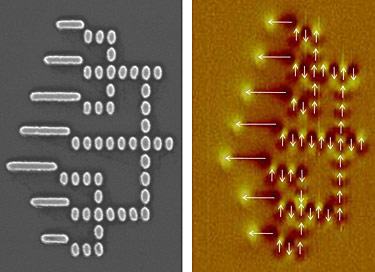
One nanoelectronics approach studied by the NRI MIND center is nanomagnet logic (NML)--logic circuits that work by magnetic coupling between neighboring nanoscale magnets. Here, SEM (l) and magnetic force microscope (r) images show an NML circuit that adds binary numbers.
The National Institute of Standards and Technology (NIST) announced today the selection of the Nanoelectronics Research Initiative (NRI), a collaboration of several key firms in the semiconductor industry, to support university-centered research for the development of after-the-next-generation "nanoelectronics" technology. NRI is made up of participants from the semiconductor industry, including GLOBALFOUNDRIES, IBM, Intel, Micron Technology and Texas Instruments.
"The NRI is a model for industry-driven consortia," said NIST Director Patrick Gallagher. "It funds a highly leveraged, coordinated nanoelectronics research program centered at leading universities in partnership with federal and state government agencies. The innovation stemming from this NIST award will enable the United States to keep our current leadership in nanoelectronics that stimulates the economy and creates high-paying jobs."
NIST will provide $2.6 million to the effort for up to five years, matched by $870 thousand each year from NRI. The program funds research at university centers around the country that are working to develop the fundamental nanoscale technologies that will be needed in the future to replace the aging CMOS ("complementary metal–oxide–semiconductor") transistor technologies at the heart of today's state-of-the-art electronics. Over the past few decades, silicon-based CMOS circuits have relentlessly followed a path of getting smaller and more complex and powerful. However, the basic underlying transistor technology is approaching physical limits.
"Continued progress by the electronics industry will require something very different. Future generations of electronics will be based on new devices and circuit architectures, operating on physical principles that cannot be exploited by conventional transistors," said Tom Theis, director of the NRI.
The new award is essentially the successor to an earlier five-year collaboration between NRI and NIST that also focused on the long-term goal of "developing the next logic switch." The earlier program concentrated largely on the problem of developing the basic logic elements that are the building blocks of electronic devices. The new program will broaden the scope to consider novel circuit architectures and devices that combine logic with memory, analog and other functions to provide high "computational density."
The NRI initiative was launched by the Semiconductor Industry Association (SIA) in 2005. The NRI and the collaboration with NIST are managed by the Nanoelectronics Research Corporation (NERC), a special-purpose subsidiary of the Semiconductor Research Corporation (SRC).
"The NRI seeks to insure that the United States remains the leader in cutting-edge semiconductor research and is home to the 'nanoelectronics' industry of the future," said SRC President Larry Sumney.
Since its inception, the NRI program has involved the research of nearly 500 students from more than 55 universities, resulting in 34 patent applications with seven patents granted and citations in more than 1,900 research publications. NRI currently supports four principle university-led research centers to pursue this work, including:
- the Western Institute of Nanoelectronics (WIN) in California,
- the Midwest Institute of Nanoelectronics Discovery (MIND) in Indiana,
- the Institute for Nanoelectronics Discovery and Exploration (INDEX) in New York, and
- the SouthWest Academy of Nanoelectronics (SWAN) in Texas.
The award to NRI was the result of a competition announced by NIST last spring; see the March 20, 2012, news item "NIST Announces $2.6 Million in Funding for Novel Semiconductor Research." Additional information on NRI is available at www.src.org/program/nri/.

